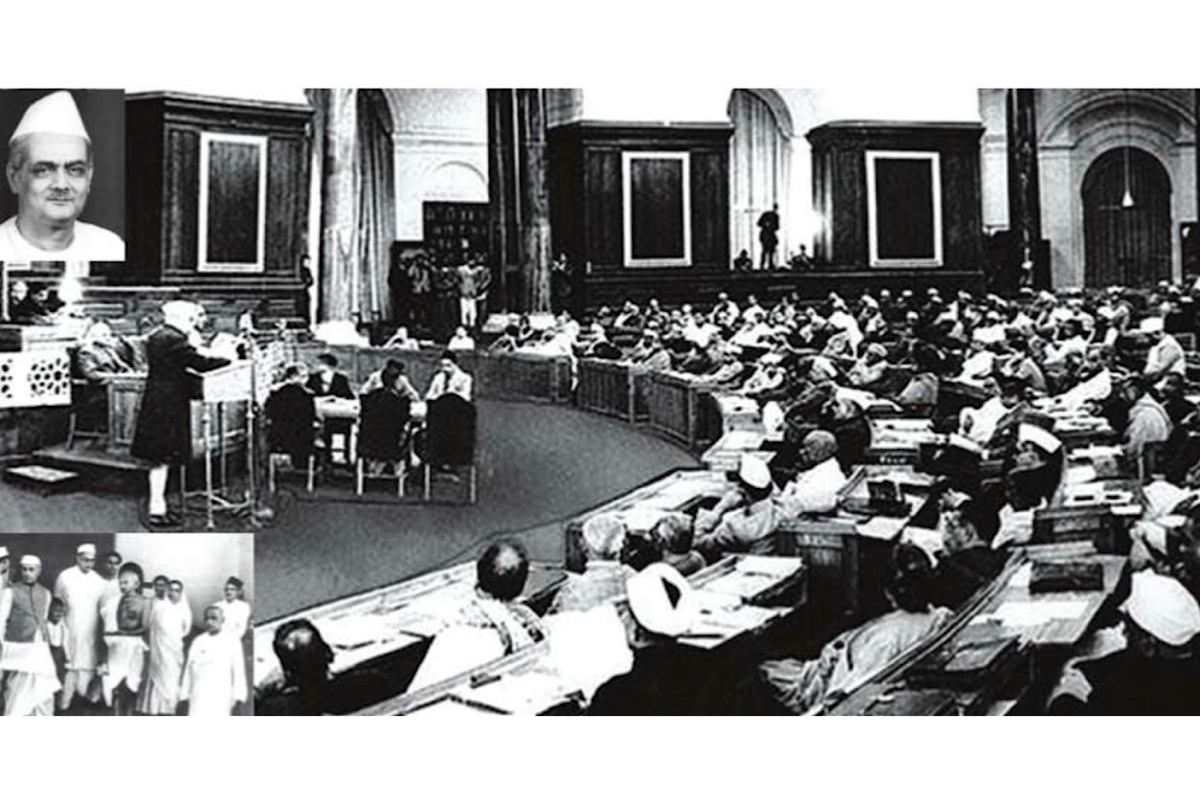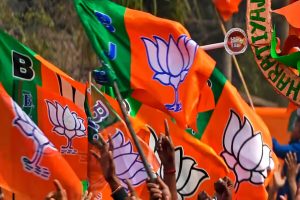The post-Independence Indian party system followed the pattern set in the last three decades of the freedom movement. The Gandhian Congress was the dominant party but not the only party. There were many other smaller outfits. The Congress was an umbrella party with many factions with differing perspectives.
After partition and Independence, India and Pakistan moved in different directions though both began their post-independence journey with one party being dominant. Pakistan oscillated between civilian and military rule while India stabilized as a democracy defying ominous projection by commentators like Selig Harrison who predicted that India would break up. Samuel P. Huntington attributed this success to the existence of two organizations, one an efficient and independent civil service and the other, a well-organized political party, the Indian National Congress.

Ever since the advent of Gandhi, the Congress adopted a new constitution, yearly electi- ons and expanded itself to every nook and corner of the country so much so that in every Indian village, there were two constants, one a postman and the other a Congressman. In contrast, the Muslim League resembled a pressure group with an inherent elitist bias. Jinnah subsequently imbibed the form but not the substance of the Congress party.
Duverger’s law on the party system attributes the existence of a number of parties to the electoral system. The representation- al party system will lead to many different political formations whereas the first past-the-post majority system would lead to a two-party system or two alliances and within a party dominant factions, like the ones that existed within the Congress, namely the supporters of Nehru and those of Patel who would co-exist.
Within the BJP it is those who belong to the RSS and those that do not. Even the united Communist Party had two discernible lines, one the Kerala line and the Bengal line, apart from the splinter groups which operated independently.
In Kothari’s Congress system, the coalitional basis of the party was its basic strength. In the heyday of the Congress one party dominant system, Speaker Mavlankar stipulated that an official opposition party status would require a minimum presence of 10 per cent in the Lok Sabha. The underlying assumption was that with the maturing of democracy, a balanced party system would evolve and a well-defined space would facilitate accommodation of the opposition to be effective and articulate and eventually become part of the government, as is the practice in Britain.
The opposition in Britain is His Majesty’s opposition and even has a shadow cabinet. It really did not matter even when in Britain the Conservatives were the natural party of governance and Labour, an interventionist party. L K Advani in the 1990s was of the
view that the BJP would slowly lead a coalition that would be a natural governing party in India and even envisaged a shadow cabinet within it.
The evolution from non-Congressism to non-BJP formation has taken different forms and
turns. After Patel’s death in 1950, the Nehru faction within the Congress became the dominant one. But a sizable minority continued, similar to the continuation of the Swarajists within the Congress in the 1920s. In the election for the post of president of the Congress in 1950, Purushottam Das Tandon and Acharya J B Kriplani were the contenders. The former won with the support of Patel.
Rajendra Prasad secured the consent of the party for a second term as president with the support of the Patel faction and despite Nehru’s stiff opposition. Maulana Azad played a significant role on both occasions. Lohia combined anti-Congressism with anti-Nehrism and the first major success came in the 1967 election when the Congress was dislodged from power in the provincial elections from Punjab to West Bengal and in Tamil Nadu where no national party could make any significant dent ever since.
The Swatantra Party (1957- 74) was a severe critique of Nehru’s Permit Licence Quota Raj and the split in the Congress in 1969 signalled the deinstitution- alization process that had begun within the Congress system as the earlier consensual basis of the party began eroding. Mrs Gandhi’s tacit support to V V Giri, though he was not the official nominee for the presidential elections in 1969 overrode the official candidate, Sanjiva Reddy. With clever planning and calcu lation, Giri won with the help of the second preference votes of the combined opposition. Minoo Masani labelled the victory as one of treachery and deception.
From 1971 to 1977, Mrs Gandhi consolidated her power because of her deft handling of the civil war in East Pakistan which led to the emergence of Bangladesh. Vajpayee compared Mrs Gandhi with Durga and in the March 1971 elections, she secured impressive victories both at the centre and states. But this tri- umph was short lived with the court verdict that set aside her election and debarred her in 1975, from political activity for the next six years. This led to the declaration of Emergency wherein prominent opposition party leaders and even some Congress leaders were detained. The term of the Lok Sabha was extended by a year. The year 1977 saw the emergence of a new party, the Janata Party consisting of the non-Congress parties except for the Communists. Jayaprakash Narain legitimized the RSS by involving it in his 1974 Total Revolution Movement. It facilitated the entry of the Jan Sangh from the periphery to the mainstream of opposition parties.
The latter displayed a remarkable sense of moderation. Despite being the largest and dominant group with 98 MPs in the Lok Sabha, it accepted Morarji Desai, detained during the Emergency, to become the Prime Minister. The unity did not last long and Mrs Gandhi regained the majority in 1980. After her assassination in 1984, Rajiv Gandhi became the Congress party leader who led his party to an impressive win with a whopping majority of 404 seats in the Lok Sabha.
But the decline of the Congress continued mainly due to over centralization within the party as Mrs Gandhi during her long stint of 17 years did not hold organizational elections, something that continued within the party subsequently. After a few short-lived coalitions, the Congress with Narasimha Rao (1991- 96) at the helm led a minority government and completed its full five-year term in office.
Vajpayee’s 13 day-government in 1996 was the first attempt by the non-Congress National
Democratic Alliance (NDA). This was followed by 13 months in government in 1998-99 and subsequently a full term from 1998 to 2004. Vajpayee advanced the elections and the Congress’s alliance, the United Progressive Alliance (UPA) won an unexpected victory in 2004. The latter won once again in 2009 bringing an end to the Advani period in the BJP. The NDA continued to be the dominant opposition formation.
In 2014, the Narendra Modi-led NDA was victorious. In 2019, the NDA won again but with the BJP securing a majority on its own, made possible primarily due to a divided opposition. The BJP with its vote share of 37 per cent had a comfortable majority, well beyond the magic number of 272. The Congress remained the main opposition party but with drastically reduced num- bers in the Lok Sabha.
The UPA rule between 2004- 14 and the NDA rule, first in 1998-2004 and from 2014 till now are decisive indicators of partial evolution of a two-party system that vindicates the Duverger formulation.
The formation of INDIA has made a shift from anti-Congressism to anti-BJPism. The elec- torate now has two broad umbrella formations: NDA and INDIA. There would be a large number of exceptions given the fact that India is a country with major contradictions. However, the general evolution is clearly manifest.
BJP’s two parliamentary seats, both from Andhra Pradesh, in 1984 and Congress’ reduced numbers in 2014 and 2019 were temporary aberrations. Proporti- onal representation perpetually fragments a party system whereas the first past-the-post system leads to consolidation of two formations. The number of seats in the Lok Sabha does not indicate the actual support of a national party as that largely depends on opposition unity or disunity.
In the first-past-the-post- system no national party is exp-ected to secure more than forty per cent vote at the national level in an election.
In any future election for the Lok Sabha, the opposition space will always remain. India sans either the Congress or the BJP is not possible given the federal nature of our polity as that allows for smaller regional parties which would veer towards one or the other national alliances endorsing the traditional adage that there are no permanent friends or permanent enemies in politics but only permanent interests.
(The writer is a retired Professor of Political Science, University of Delhi)












